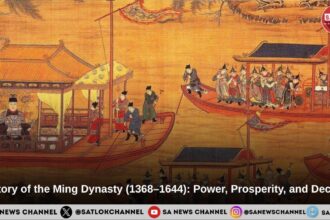Chanel is one of the most prestigious names in the world of fashion. It is not only a fashion brand but is a symbol of luxury, innovation, and elegance. Founded by Gabrielle “Coco” Chanel in the early 20th century, the fashion brand has modernised the fashion industry through revolutionary designs.
- Early Life and Childhood of Gabrielle “Coco” Chanel
- How Coco Chanel Revolutionized Women’s Fashion
- The Birth of the Chanel Brand and Its Signature Styles
- Chanel No. 5: The Perfume That Changed the Industry
- Coco Chanel’s Controversial Role During World War II
- Allegations of Nazi Collaboration and Spy Activities
- Operation Modellhut: Chanel’s Secret Mission to Negotiate Peace
- Overcoming Adversity: The Resilience Behind Chanel’s Success
- Coco Chanel’s Impact on Modern Fashion and Culture
- Saint Rampal Ji Maharaj: The Global Spiritual Leader
Chanel is not only a fashion house but also a cultural emblem of style, empowerment, and boldness. Although Chanel is a brand that marks luxury and elegance, the story of its founder is somewhat different. Coco Chanel’s journey was far from privileged—a girl who was once abandoned to an orphanage at 11, growing up burdened by struggle and loneliness. But this struggle did not let her dream die. Her dream of revolutionising the way women dress.
How did Chanel start? How many ups and downs did she face? What did it take for this abandoned girl to build a lasting legacy?
Her biography is not just a fashion tale but also a story of perseverance—the story of how a young girl once confined by orphanage walls broke free to create a global empire now known simply as Chanel.
Early Life and Childhood of Gabrielle “Coco” Chanel
Gabrielle “Coco” Chanel was born in 1883 to Albert Chanel, a street vendor, and Eugénie Jeanne Devolle Chanel, a laundrywoman. Chanel’s childhood was unlike that of other children. After Chanel’s mother’s death when she was just 11, her life took a darker turn. Instead of providing love or comfort, Chanel’s father sent her to live in an orphanage run by nuns. Life in the orphanage was even more difficult. Chanel grew up in a disciplined and restrained environment, her life occupied with loneliness, silence, religious rites, and strict orders.
Yet, it was also there, amidst the shadows of loneliness and loss, that she found some strength and a skill that would shape her destiny. Chanel learned to sew at the hands of the nuns. Her emotional scars from her childhood stayed with her until her death.
How Coco Chanel Revolutionized Women’s Fashion
Chanel left the orphanage at the age of 18 to move to the town of Moulins, where she lived in a convent boarding school for Catholic girls. At Moulins, Chanel worked as a seamstress in a draper’s shop on Rue de l’Horloge, where she sold clothes. She lived above the shop and worked weekends at a tailor’s, where she altered the uniforms of the cavalry officers.
Alongside working as a seamstress, Chanel also started to perform as a stage singer in local cafés and cabarets in Moulins and Vichy. Although Chanel was not a great singer, her charisma and stage presence brought her to public attention. She earned the nickname “Coco,” which may come from the titles of songs she performed, such as “Ko Ko Ri Ko” and “Qui qu’a vu Coco?” Chanel’s job as a singer helped her gain confidence and brought her into public notice, which later helped her in building her brand and persona.
The Birth of the Chanel Brand and Its Signature Styles
While working as a seamstress and singer, Chanel’s life took a different turn when she became romantically involved with a wealthy ex-cavalry officer, Étienne Balsan. Living in Balsan’s château immersed her in a new world of leisure and privilege. Soon, Chanel was Balsan’s mistress.
While enjoying her lavish life as Balsan’s mistress, Chanel was introduced to high society and its fashionable women. Chanel soon began working toward the dream she had held for many years. She started to experiment with hat designs, redesigning simple straw hats into elegant creations. These hats caught the attention of Balsan’s friends and marked the beginning of Chanel’s fashion career.
Through Balsan’s social status, Chanel met a rich English businessman and polo player, Arthur “Boy” Capel, who would not only become Chanel’s great love but also the man to transform her ambitions into reality. Capel was not only in love with Chanel but also respected her independence and recognized her talent.
He helped Chanel manage the finances and also emotionally supported her, giving her the means to move from designing hats for acquaintances to starting her own business. With Capel’s strong support, Chanel opened her first millinery shop on Rue Cambon in Paris in 1910.
Capel’s support and investment helped Chanel to expand rapidly. In 1913 she opened a boutique in Deauville, where she introduced revolutionary sportswear inspired by men’s clothing and made primarily from jersey fabric, a material which was previously reserved for men’ s underwear. Two years later, in 1915, Chanel also established a couture house in Biarritz, which became an immediate success and attracted wealthy clients even during wartime.
During these years, Chanel started creating her true signature style: simple lines, relaxed elegance, sailor-inspired blouses, and clothing that freed women from the fitted corsets and heavy gowns of the Belle Époque. Her work offered a change to the vision of women’s fashion from the traditional standards to more practical, comfortable, and elegant styles.
Among her most lasting innovations from this period were Chanel’s tailored day suits, her symbolic wide-brimmed boater hats, and later, the “little black dress,” which transformed sophistication with its pure simplicity. Contrary to the fancy designs of the past, Chanel’s style provided more clarity and moderation, proving that elegance could be achieved through minimalism.
The love story that had fueled her rise came to a painful end when Capel, despite his timeless devotion to Chanel, married Diana Wyndham. Capel’s marriage was an emotional turmoil to Chanel, yet her relationship with Capel continued discreetly until his sudden death in a car accident in 1919. Capel’s loss devastated her deeply, but the foundation he had helped her build remained unshaken.
Even after losing Capel, Chanel transformed her grief into determination, carrying forward the identity of the House of Chanel—born in love, ambition, and an unyielding quest for independence.
Chanel No. 5: The Perfume That Changed the Industry
In 1921, Coco Chanel took a major step in her career; she not only achieved fame as a fashion designer but also revolutionized the fragrance world with the launch of Chanel No. 5 — a perfume that redefined how women’s scents were perceived. To enter the fragrance industry, Chanel met French-Russian perfumer Ernest Beaux and challenged him to blend a fragrance that “smelled like a woman and not like a rose.” Beaux blended more than 80 ingredients enriched with synthetic aldehydes, resulting in Chanel No. 5.
Chanel famously chose the fifth vial of samples, inspired by her lucky number five, which she believed would bring her good fortune. The perfume’s poise, along with Chanel’s groundbreaking marketing, helped her rapidly achieve the heights of the fashion and beauty industries by the mid-1930s.
Chanel met the Wertheimer brothers, Pierre and Paul, who were the owners of a perfume company regarding the manufacture and distribution of Chanel No. 5. The Wertheimer brothers, recognizing Chanel No. 5’s immense potential, formed a partnership, helping Chanel monetize her creation on a global scale while she took charge of the creative control.
Also Read: Biography of Michelangelo: Life, Legacy and Artworks
Chanel No. 5 did not only establish Chanel as a major player in the industry of perfumes, it sparked enormous commercial competition. The original deal for Chanel No. 5 allocated the majority of profit to Pierre and Paul Wertheimer— the financial supporters who oversaw production and distribution— leaving Chanel with a very small fraction.
As No. 5 was a success, Chanel became incensed by this arrangement as she was not only losing profit, but was losing power. She initiated a lawsuit against the Wertheimer brothers, contesting the clauses of the deal and trying to reclaim ownership of her scent. The ensuing court battles heated up over time, and exposed a long-standing strife between creative ownership and business partnerships in the luxurious fashion industry.
Coco Chanel’s Controversial Role During World War II
Coco Chanel’s career was at its heights when World War II struck, with her fashion empire employing around 3,000 to 4,000 women. Her classic and elegant designs had made her a titan of haute couture. However, at the outbreak of war in 1939, Chanel abruptly closed her couture house, believing that fashion was no longer a commercial or appropriate pursuit during such difficult times.
She famously said, “How could I suppose there would still be people who would buy dresses?” This sudden closure left thousands of her employees jobless. When the German occupation of Paris started in 1940, Chanel stayed at Hotel Ritz of the city, a place that became the headquarters of the Luftwaffe (the air force of Nazi Germany), where high-ranking German officers lodged.
Allegations of Nazi Collaboration and Spy Activities
While staying at the Ritz, Chanel started a romantic relationship with Baron Hans Günther von Dincklage, who was a German aristocrat and spy. Chanel’s connection with Dincklage deepened her involvement with the Nazis. She conspired with the Nazi intelligence service, the Sicherheitsdienst (SD), and was assigned the codename “Westminster,” as alleged by some sources. Chanel took advantage of her social and political connections to advance Nazi interests, including attempts to take over the Chanel perfume business from its Jewish owners — the Wertheimer brothers—by exploiting Aryanization laws during the occupation.
Operation Modellhut: Chanel’s Secret Mission to Negotiate Peace
Operation Modellhut was a scandalous incident that revealed Chanel’s association with the Nazis. Chanel went to Madrid in 1943 on a secret mission to try and establish peace between Britain and Germany using her connections such as Winston Churchill.
Chanel was temporarily arrested after the war but escaped prosecution when British intelligence intervened, most likely because she had useful knowledge regarding prominent members of British high society. She then fled to Switzerland and avoided the limelight and fashion establishment for some 15 years. Chanel made a legendary return in 1954, reopening her couture business and reclaiming her position within the fashion community.
Her wartime activities remain a deeply problematic and controversial aspect of her reputation, a mix of survival, opportunism, and morally dubious collaboration with the enemy.
Overcoming Adversity: The Resilience Behind Chanel’s Success
After staying fifteen years away from the fashion world, Coco Chanel returned to the industry in 1954. This demonstrates her incredible persistence through widespread hostility and controversy over her wartime activities. With the change in fashion and the emergence of many new designers like Christian Dior and Cristóbal Balenciaga, Chanel courageously revived her Chanel suit and quilted handbag into something modern and relevant, and once again made her mark on haute couture as a leading figure in fashion.
Chanel continued to work and create until her last day. Coco Chanel died at the age of 87 on January 10, 1971, in her hotel suite at the Hotel Ritz in Paris, while working on a new collection. Even on her last day, she was preparing a new collection, embodying her relentless dedication to fashion and style.
Coco Chanel’s Impact on Modern Fashion and Culture
Coco Chanel’s impact is colossal in the history of fashion, making her one of history’s most impactful designers. She broke away from the conservative corsets and elaborate styles of the 19th century and introduced simplicity, sophistication, and functionality into women’s fashion instead. Chanel’s legendary designs, including the little black dress, the Chanel suit, and the quilted handbag, have become ageless classics, a synergy of elegance and simplicity.
In addition to clothing , Chanel’s vision liberated women to become independent and contemporary, capturing and projecting evolving social roles. The house of Chanel today is still going strong, upholding the spirit of innovation and fashion she fostered, inspiring generations of designers and fashion enthusiasts globally. Her philosophy—that authentic style was more than an ephemeral trend—remains a guiding principle in today’s fashion industry, so her influence is lasting and profound.
Saint Rampal Ji Maharaj: The Global Spiritual Leader
As Coco Chanel is to the fashion industry, the symbol of liberty, breaking boundaries, revolutionary fashion designer.
Similarly, Saint Rampal Ji Maharaj ji is the revolutionary Spiritual Leader, who is providing a true way of worship to free our souls from the trap of birth and death. Saint Rampal Ji Maharaj is providing the true scripture based worship of God Kabeer Saheb Ji, who is the creator of the universe. For more information about Saint Rampal Ji Maharaj visit www.jagatgururampalji.org or read sacred books Gyan Ganga and Way Of Living.









